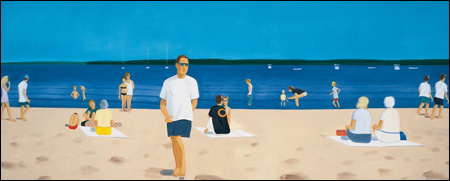You wouldn’t think a painting exhibit of ships and still lifes, landscapes and portraits, primitives and abstractions representing 82 artists and spanning 148 years (the oldest, Fitz Henry Lane’s Castine, Maine dates from 1856; the newest, Scott Prior’s Apple Tree, dried to a finish the year before last) would hold together in any discernible way. And you’d be mostly right. The sprawling, uneven, frequently enjoyable collection of summertime paintings of New England at the Peabody Essex Museum by artists who come from here or settled here or summered here or simply passed through feels little more cohesive than a Security Council meeting at the United Nations. Yes, the delegates have gathered in one place, but the languages they speak and the interests they represent are global. The thematic looseness of “Painting Summer in New England” is implicit in curator Trevor Fairbrother’s catalogue essay when he writes, “The diverse works all have two properties in common: each is a subjective arrangement of pigmented substances on a flat surface, and, as a result, each is an invention or fictional exercise.” Is there a painting of the last 1000 years about which that can’t be said?


HARBOR #9: Alex Katz’s wall-sized work exceeds the limits of his cartoonish minimalism. |
“I sought a theme and sought for it in vain,” begins William Butler Yeats’s “The Circus Animals’ Desertion,” and just when you’re prepared for the high seriousness of the creative search, the poet undermines it with the next line, “I sought it daily for six weeks or so.” “Painting Summer” enjoys no such irony — the theme is relentlessly pursued through rather bogus groupings (“Streets and Gathering Places,” “Individuals,” “New England Nudes”), with the result that you come away with gratitude for glimpsing a number of gems, annoyance for being made to look at some forgettable tripe (just what is Leon Kroll’s Cape Ann doing here?), and at least one or two breakthrough realizations about artistic influences and affinities that you never before appreciated.
One of the big surprises comes when you first walk into the six-gallery exhibit to stand before Neil Welliver’s giant (8’x8’) but tame Late Light, a 1978 oil that depicts a sylvan hillside of boulders and trees done in shades of green available only in art-supply stores. Off to the right and so diminutive as to go almost unnoticed (you could fit nearly 200 of them onto Welliver’s canvas) is Scott Prior’s 6”x6” Picnic Table by the Sea, a work of such luminous clarity that to see it once is to remember it forever. An immaculately empty picnic table occupies the foreground of this expansive miniature against a dark backdrop of a calm ocean made glass — like a setting sun. As in his Path to the Lake (he’s the most featured artist in the show), in which the light in the ceiling of a lone phone booth mimics the yellow sky of another setting sun, Prior positions solitary, manufactured, commonplace objects in manicured outdoor settings. Order prevails, though it never feels precious or staged so much as hard won, as if the effort to tame the land were one and the same with the effort to mass-produce objects.